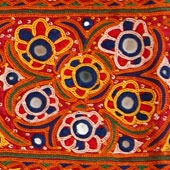Design Resource
Rabari Embroidery - Bhujodi
Inspired by Mythology and Desert Habitation
by
Embroidery is an integral part and a decorative work of a needle in which designs are created by stitching stands of material on to a layer of another material. Embroidery of choli (blouse) is the most important art form because it is heavily embroidered ornamentation. They attach different shapes of mirrors around which the embroidery thread is revolved.
Embroidery is a needle work and color thread of woolen or cotton is inserted through the eye of the needle which are stitched along the cotton or woolen cloths. These cloths are usually procured from Bhuj and nearby towns.
The artisan creates traditional patterns using chain stitches and a liberal use of mirrors. The varieties in this embroidery are mainly observed in the placement of the mirrors and the fascinating stitches made along the borders, they use glass mirror in various shapes like round, diamond, rectangular, square, triangular shape. The compositions created comprise specific motifs each of which has a name and meaning. The women depict the world around them, without the help of sketches or patterns. Chain stitch (Shankari) accompanied by an array of accent stitches adds in graphically illustrative quality in their needlework.
Back stitch is also locally called as ‘bakhiya’ which is one of the stitches that adds lot of emphasis on the creative work. Contrasting and non-repetitive use of colors is one of the most distinctive characteristics of Rabari embroidery. This embroidery is like expiration (running out, does in free time) of women who usually does this in afternoon time after their household works. The motifs of the Rabari embroidery are usually derived from the everyday life that shows how the community sees their world. The style of the embroidery is not static as these stitches and color changes as per the spontaneity and imagination of the artist. It is the expression, creativity and amazing capacity of adaptation that keeps this craft constantly evolving and their tradition vital.










